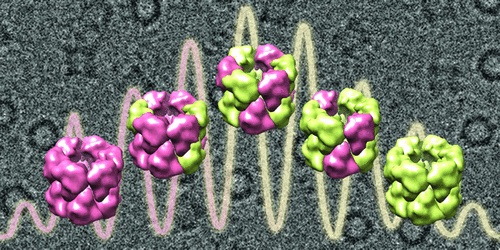A Tunable Plant Pseudoenzyme-Enzyme Complex Regulates B6 Production
09/14/2021

Enzyme-pseudoenzyme complexes involved in vitamin B6 synthesis display variable stoichiometry. Heterocomplexes of enzyme PDX1.3 (purple) and pseudoenzyme PDX1.2 (yellow) can be coexpressed in different ratios to achieve different activities. [Reprinted with permission from Novikova, I. V., et al. 2021. Tunable heteroassembly of a plant pseudoenzyme-enzyme complex. ACS Chem. Biol., 16 (11), 2315–2325. Copyright 2021 American Chemical Society.]
Pseudoenzymes—catalytically deficient or inactive homologs of active enzymes—can act as regulatory elements, often by pairing with their active counterparts. However, the high structural similarities between pseudoenzymes and canonical enzymes create challenges for unraveling their mechanisms of action using classical molecular and biochemical characterization approaches. Vitamin B6 biosynthesis in plants is one example where pseudoenzyme-enzyme pairing, called heterocomplexation, between the enzyme PDX1.3 and the pseudoenzyme PDX1.2 impact overall activity, yet the mechanism remained unclear.
Researchers from four institutions, including the Environmental Molecular Sciences Laboratory (EMSL), used a unique combination of cryo-EM, cell-free expression, activity assays, and native mass spectrometry to determine the atomic structure and manipulate the degree of pseudoenzyme-enzyme pairing. The various pseudoenzyme-enzyme pair associations exhibited variable stoichiometry that was tunable, solving an open question on the mechanism of heterocomplex assembly and activity regulation. Instead of forming discrete rings of pure pseudoenzyme or enzyme hexamers that can interact in a ring-ring association, the results revealed that the pseudoenzyme and enzyme subunits interact both within and between each ring layer.
Related Links
References
Novikova, I. V., et al. 2021. Tunable heteroassembly of a plant pseudoenzyme-enzyme complex. ACS Chem. Biol., 16 (11), 2315–2325. [DOI: 10.1021/acschembio.1c00475]
